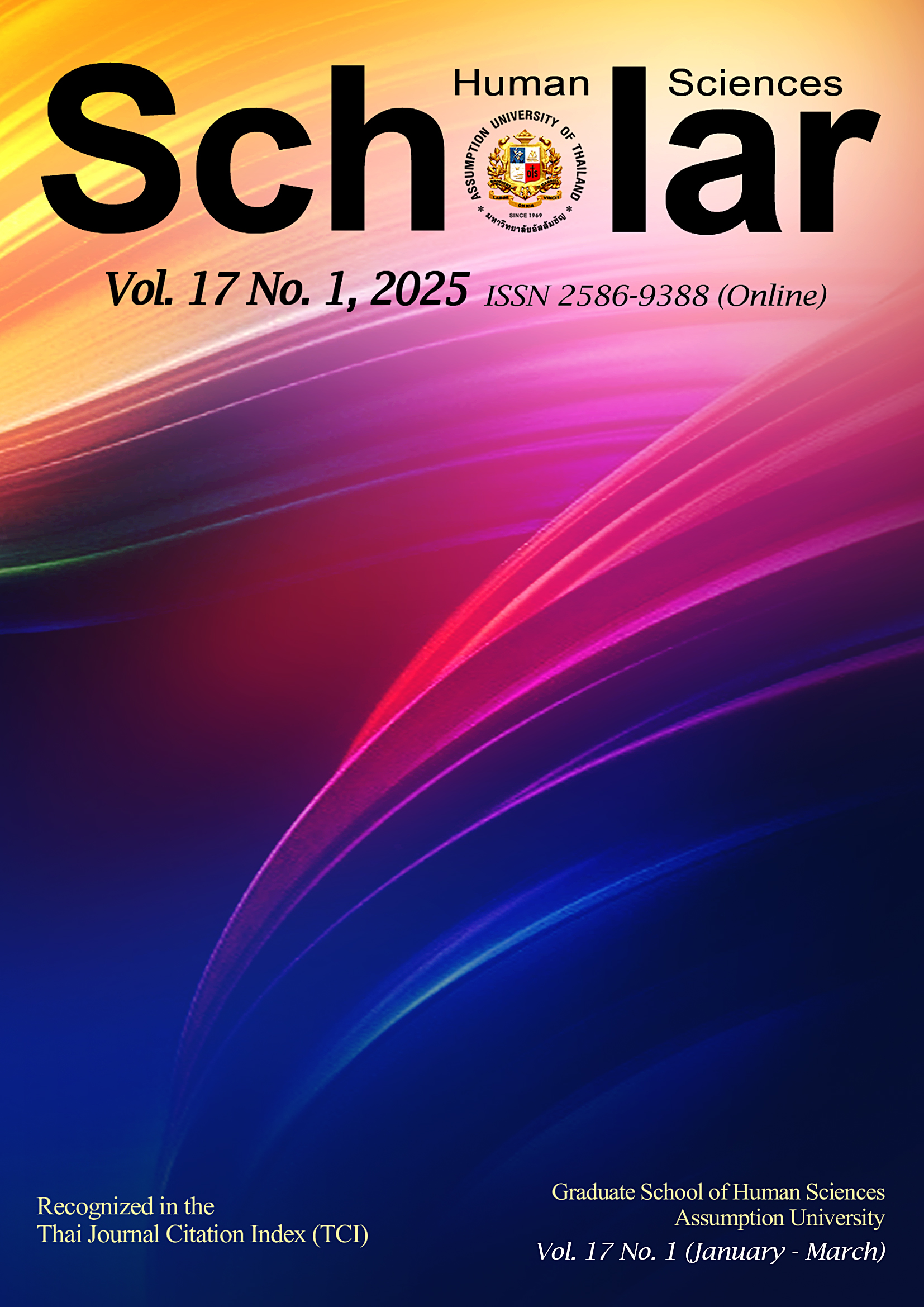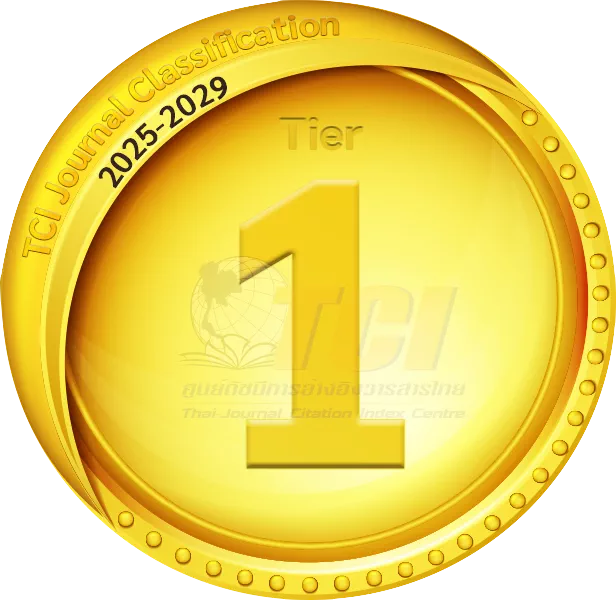Blended Learning Satisfaction Among Art Students in Local Universities in Sichuan, China
DOI:
https://doi.org/10.14456/shserj.2025.1Keywords:
Art Students, Blended Learning, Student Satisfaction, Higher Education, Ethnic UniversitiesAbstract
Purpose: This study explored the influencing factors of art students' satisfaction with blended learning in local colleges in Sichuan. The conceptual framework proposes a causal relationship between faculty services, academic aspects, reputation, heritage, trust, service quality, and students’ satisfaction. Research design, data, and methodology: The researcher used quantitative methods (n=500) to survey undergraduate art students in local ethnic colleges and universities in Sichuan. Three target universities were selected. The sampling techniques are judgmental, stratified random and convenience sampling. The index of item-objective congruence (IOC) and Cronbach’s alpha reliability were used before the data collection. This study used structural equation modeling (SEM) and confirmatory factor analysis (CFA) for data analysis, including model fit, reliability, and validity. Results: Faculty services, academic aspects, reputation, heritage, trust, and service quality have a significant impact on students’ satisfaction. In addition, trust has a significant impact on reputation. However, service quality has no significant impact on reputation. Conclusions: Therefore, it is recommended that institutions of higher learning and administrators should pay attention to faculty services and trust to improve student satisfaction and increase the competitiveness of schools. The results imply that universities should prioritize enhancing faculty service as a fundamental element of their strategy to boost student satisfaction.
References
Abdullah, F. (2005). HEdPERF versus SERVPERF: the quest for ideal measuring instrument of service quality in higher education sector. Quality Assurance in Education, 13(4), 305-328. https://doi.org/10.1108/09684880510626584
Abdullah, F. (2006). The development of HEdPERF: a new measuring instrument of service quality for the higher education sector. International Journal of Consumer Studies 30(6), 569-581. https://doi.org/10.1111/j.1470-6431.2005.00480.x
Ahmed, I., Nawaz, M. M., Ahmad, Z., Ahmad, Z., Shaukat, M. Z., Usman, A., Rehman, W. U., & Ahmed, N. (2010). Does service quality affect students’ performance? Evidence from institutes of higher learning. African Journal of Business Management, 4(12), 2527-2533.
Ainur, A. K., Deni, S., Zeinab, J., & Yep, B. W. (2017). Sample size and non-normality effects on goodness of fit measures in structural equation models. Pertanika Journal of Science and Technology, 25(2), 575-586.
Ali, F., Zhou, Y., Hussain, K., Nair, P. K., & Ragavan, N. A. (2014). Does higher education service quality effect student satisfaction, image, and loyalty? A study of international students in Malaysian public universities. Quality Assurance in Education, 24(1), 70-94. https://doi.org/10.1108/qae-02-2014-0008
Ali, F., Zhou, Y., Hussain, K., Nair, P. K., & Ragavan, N. A. (2016). Does higher education service quality effect student satisfaction, image, and loyalty? A study of international students in Malaysian public universities. Quality Assurance in Education, 24(1), 70-94.
Alves, H., & Raposo, M. (2007). Conceptual Model of Student Satisfaction in Higher Education. Total quality management & business excellence, 18(5), 571-588.
https://doi.org/10.1080/14783360601074315
Arif, S., Ilyas, M., & Hameed, A. (2013). Student satisfaction and impact of leadership in private universities. The TQM Journal 25(4), 1754-2731. https://doi.org/10.1108/17542731311314881
Astin, A. W. (1999). Student involvement: a development theory for higher education. Journal of College Student Development, 40(5), 518-529.
Berry, L. L. (2000). Cultivating service brand equity. Journal of the Academy of Marketing Science, 28(1), 128-137. https://doi.org/10.1177/0092070300281012
Brodie, R. J., Whittome, J. R., & Brush, G. J. (2009). Investigating the service brand: a customer value perspective. Journal of Business Research, 62(3), 345-355.
https://doi.org/10.1016/j.jbusres.2008.06.008
Bromley, D. B. (2002). An examination of issues that complicate the concept of reputation in business studies. International Studies of Management & Organization, 32(3), 65-81.
https://doi.org/10.1080/00208825.2002.11043666
Brown, R. M., & Mazzarol, T. W. (2009). The importance of institutional image to student satisfaction and loyalty within higher education. Higher Education 58(1), 81-95.
https://doi.org/10.1007/s10734-008-9183-8
Brown, T. A. (2015). Confirmatory factor analysis for applied research (2nd ed.). Guilford publications.
Bryk, A. S., & Schneider, B. (2004). Trust in Schools: A Core Resource for Improvement. Contemporary Sociology, 33, 368-369.
Bulotaite, N. (2003). University heritage—an institutional tool for branding and marketing. Higher Education in Europe, 28(4), 449-454. https://doi.org/10.1080/0379772032000170417
Byrne, B. M. (2011). Structural equation modeling with AMOS: Basic concepts, applications, and programming (2nd ed.). Routledge/Taylor & Francis Group.
Chadwick, K., & Ward, J. (1987). Determinants of consumer satisfaction with education: implications for college and university administrators. College and University, 62, 236-246.
Clark-Carter, D. (2009). Quantitative Psychological Research: The Complete Student's Companion: The Complete Student's Companion (1st ed.). Psychology Press.
Creswell, J. W. (2014). Research design: qualitative, quantitative, and mixed methods approach (4th ed.). SAGE Publications.
Darby, M. R., & Karni, E. (1973). Free competition and the optimal amount of fraud. The Journal of Law and Economics, 16(1), 67-88. https://doi.org/10.1086/466756
Darolia, R., & Koedel, C. (2011). Faculty Service and Student Satisfaction: The Role of Institutional Demographics. Journal of Administrative and Economic Sciences, 9(1), 459-477.
Delgado-Ballester, E., & Luis Munuera-Alemán, J. (2001). Brand trust in the context of consumer loyalty. European Journal of Marketing, 35(11/12), 1238-1258.
Durvasula, S., Lysonski, S., & Madhavi, A. D. (2011). Beyond service attributes: do personal values matter?. Journal of Services Marketing, 25(1), 33-46.
Fornell, C., & Larcker, D. F. (1981). Evaluating Structural Equation Models with Unobservable Variables and Measurement Error. Journal of marketing research, 18(1), 39-50.
https://doi.org/10.1177/002224378101800104
Grönroos, C. (1984). A service quality model and its marketing implications. European Journal of Marketing, 18(4), 36-44. https://doi.org/10.1108/eum0000000004784
Hair, J. F., Black, W. C., Babin, B. J., Anderson, R. E., & Tatham, R. L. (2006). Multivariate data analysis (6th ed). Pearson Prentice Hall.
Hair, J. F., Celsi, M. W., Oritinau, D. J., & Bush, R. P. (2013). Essentials of Marketing Research (1st ed.). John Wiley & Sons.
Hair, J. F., Money, A. H., Samouel, P., & Page, M. (2007). Research Methods for Business. Education + Training, 49(4), 336-337. https://doi.org/10.1108/et.2007.49.4.336.2
Hu, L. T., & Bentler, P. M. (1999). Cutoff criteria for fit indexes in covariance structure analysis: Conventional criteria versus new alternatives. Structural equation modeling: a multidisciplinary journal, 6(1), 1-55. https://doi.org/10.1080/10705519909540118
Johnson, M. D., Gustafsson, A., Andreassen, T. W., Lervik, L., & Cha, J. (2001). The evolution and future of national customer satisfaction index models. Journal of Economic Psychology, 22, 217-245. https://doi.org/10.1016/s0167-4870(01)00030-7
Juillerat, S., & Schreiner, L. A. (1996). The role of student’s satisfaction in the assessment of institutional effectiveness. Assessment Update, 8(1), 8-9.
https://doi.org/10.1002/au.3650080108
Kanji, G. K., Tambi, A. M. A., & Wallace, W. (1999). A comparative study of quality practice in higher education institutions in the US and Malaysia. Total Quality Management, 10(3), 357-371. https://doi.org/10.1080/0954412997884
Kotler, P., & Keller, K. (2012). Marketing Management (1st ed.). Prentice Hall.
Kuo, Y., & Ye, K. (2009). The causal relationship between service quality, corporate image and adults’ learning satisfaction and loyalty: a study of professional training programmes in a Taiwanese vocational institute. Total Quality Management, 20 (7), 749-762. https://doi.org/10.1080/14783360903037085
Lai, F., Griffin, M., & Babin, B. J. (2009). How quality, value, image, and satisfaction create loyalty at a Chinese telecom. Journal of Business Research, 62(10), 980-986.
https://doi.org/10.1016/j.jbusres.2008.10.015
Lefcheck, J. (2021). Structural equation modeling in R for ecology and evolution. Methods in Ecology and Evolution, 1(2), 573-579.
Marshall, S. M., & Creswell, J. W. (2017). The Role of Trust in Higher Education: Its Impact on Student Satisfaction and Engagement. Journal of Higher Education Policy and Management, 1(3), 183-197.
Martirosyan, N. (2015). An examination of factors contributing to student satisfaction in Armenian higher education. International Journal of Educational Management, 29(2), 177-191.
Mccollough, M. A., & Gremler, D. D. (1999). Guaranteeing student satisfaction: an exercise in treating students as customers. Journal of Marketing Education, 21(2), 118-130.
https://doi.org/10.1177/0273475399212005
Navarro, M. M., Iglesias, M. P., & Torres, P. R. (2005). A new management element for universities: satisfaction with the offered courses. International Journal of Educational Management, 19(6), 505-526.
Nelson, P. (1970). Information and consumer behavior. Journal of Political Economy, 78(2), 311-329. https://doi.org/10.1086/259630
Nguyen, B., Yu, X., Melewar, T. C., & Hemsley-Brown, J. (2016). Brand ambidexterity and commitment in higher education: an exploratory study. Journal of Business, 26(1), 3105-3112. https://doi.org/10.1016/j.jbusres.2016.01.026
Nguyen, N., & Leblanc, G. (2001). Image and reputation of higher education institutions in students’ retention decisions. The International Journal of Education Management, 15(6), 303-311. https://doi.org/10.1108/eum0000000005909
Panda, S., Pandey, S. C., Bennett, A., & Tian, X. (2019). University brand image as competitive advantage: a two-country study. International Journal of Educational Management, 33(2), 234-251. https://doi.org/10.1108/ijem-12-2017-0374
Parasuraman, A., Zeithmal, V., & Berry, L. (1988). SERVQUAL: a multiple item scale for measuring consumer perceptions of service quality. Journal of Retailing, 64(1), 12-40.
Rowley, J. (1997). Beyond service quality dimensions in higher education and towards a service contract. Quality Assurance in Education, 5(1), 7-14. https://doi.org/10.1108/09684889710156530
Samad, S., Kasim, R. S. R., & Isa, M. F. M. (2017). Faculty Service and Student Satisfaction: An Exploratory Study in a Malaysian Private University. Journal of Marketing for Higher Education, 9(1), 243-258.
Schermelleh-Engel, K., Moosbrugger, H., & Müller, H. (2003). Evaluating the fit of structural equation models: Tests of significance and descriptive goodness-of-fit measures. Methods of psychological research online, 8(8), 23-74.
Shank, M. D., Walker, M., & Thomas, H. (1995). Understanding professional service expectations: Do we know what our students expect in a quality education?. Journal of Professional Service Marketing, 13(1), 71-89.
https://doi.org/10.1300/j090v13n01_08
Shu, X., & Liu, J. (2019). The Role of Institutional Trust in Shaping Students' Satisfaction with College. Journal of College Student Development, 31(6), 1-16.
Sica, C., & Ghisi, M. (2007). The Italian versions of the Beck Anxiety Inventory and the Beck Depression Inventory-II: Psychometric properties and discriminant power. In M.A. Lange (Ed.), Leading - Edge psychological tests and testing research (pp. 27-50). Springer.
Sirdeshmukh, D., Singh, J., & Sabol, B. (2002). Consumer trust, value, and loyalty in relational exchanges. Journal of Marketing, 66(1), 15-37. https://doi.org/10.1509/jmkg.66.1.15.18449
Standifird, S. S., Mills, M. J., & Baker, W. E. (2011). Faculty Service: A Key Driver of Student Satisfaction. Journal of Marketing for Higher Education, 10(2), 7-22.
Subrahmanyam, A., & Shekhar, B. R. (2017). Where do you find loyalty in the contemporary university scene?. Journal of Applied Research in Higher Education, 9(3), 378-393.
https://doi.org/10.1108/jarhe-01-2016-0004
Sultan, P., & Wong, H. Y. (2011). Service quality in a higher education context: antecedents and dimensions. International Review of Business Research Papers, 7(2), 755-784.
Sultan, P., & Wong, H. Y. (2012). Service quality in a higher education context: an integrated model. Asia Pacific Journal of Marketing and Logistics 24(5), 755-784.
Tavakol, M., & Dennick, R. (2011). Making sense of Cronbach's alpha. International journal of medical education, 2, 53-55. https://doi.org/10.5116/ijme.4dfb.8dfd
Tinto, V. (1975). Dropouts from higher education: a theoretical synthesis of recent research. Review of Educational Research, 45(1), 89-125. https://doi.org/10.3102/00346543045001089
Urde, M., Greyser, S. A., & Balmer, J. M. (2007). Special Issue Papers Corporate brands with a heritage. Journal of Brand Management, 15(1), 4-19.
https://doi.org/10.1057/palgrave.bm.2550106
Yazdanparast, A., Casidy, R., & Wasti, N. (2017). Trust and satisfaction in higher education: A review of literature. Journal of Marketing for Higher Education, 2(3),174-193.
Yeo, R. K. (2008). Brewing service quality in higher education: characteristics of ingredients that make up the recipe. Quality Assurance in Education, 16(3), 266-286.
https://doi.org/10.1108/09684880810886277
Zhang, Y., Xu, Y., Shang, L., & Rao, K. (2007). An investigation into health informatics and related standards in China. International Journal of Medical Informatics, 76(8), 614-620. https://doi.org/10.1016/j.ijmedinf.2006.05.003
Downloads
Published
How to Cite
Issue
Section
License
Copyright (c) 2025 Tongcheng Liu

This work is licensed under a Creative Commons Attribution 4.0 International License.
The submitting author warrants that the submission is original and that she/he is the author of the submission together with the named co-authors; to the extend the submission incorporates text passages, figures, data, or other material from the work of others, the submitting author has obtained any necessary permission.
Articles in this journal are published under the Creative Commons Attribution License (CC-BY What does this mean?). This is to get more legal certainty about what readers can do with published articles, and thus a wider dissemination and archiving, which in turn makes publishing with this journal more valuable for you, the authors.




